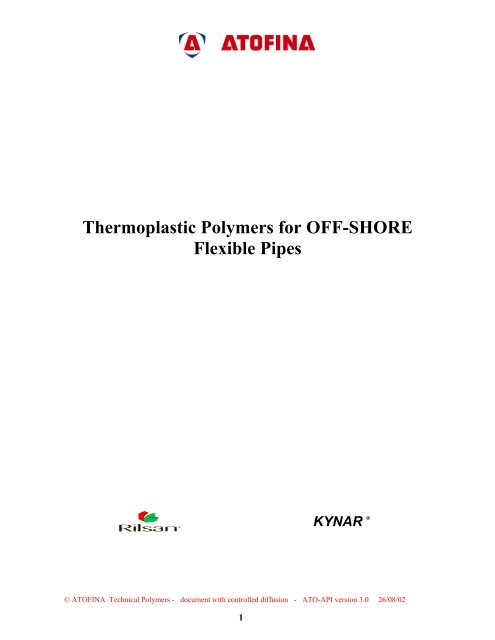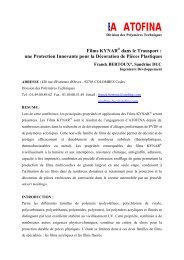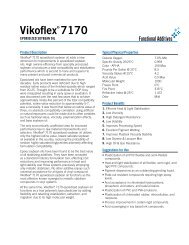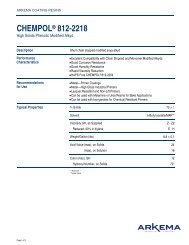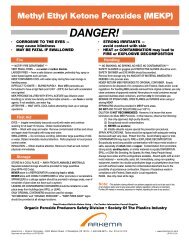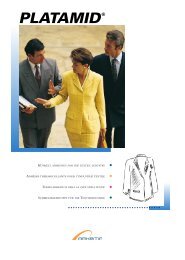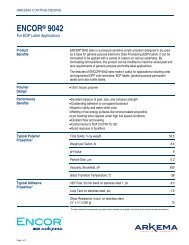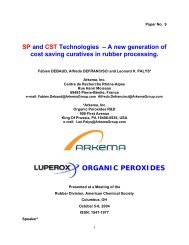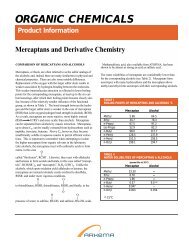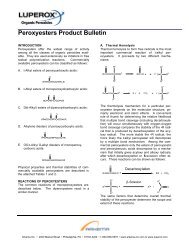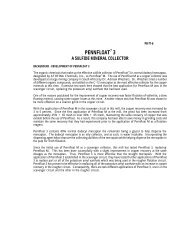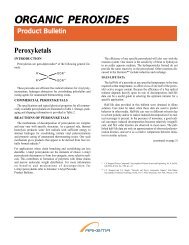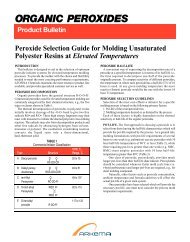E - Arkema Inc.
E - Arkema Inc.
E - Arkema Inc.
You also want an ePaper? Increase the reach of your titles
YUMPU automatically turns print PDFs into web optimized ePapers that Google loves.
Thermoplastic Polymers for OFF-SHORE<br />
Flexible Pipes<br />
© ATOFINA Technical Polymers - document with controlled diffusion - ATO-API version 3.0 26/08/02<br />
1<br />
KYNAR ®
RILSAN ® , the unique polyamide from ATOFINA, today looks back at a service history of 30<br />
years in the petrol industry. After 14 years of research in a program launched in 1958 by the<br />
French Institut de Petrole, PA11 was chosen as the best material out of several hundred<br />
tested. The combined qualities of flexibility, excellent impact resistance even at low<br />
temperatures, high resistance to ageing and good compatibility to products common to the<br />
petrol industry environment have made RILSAN ® an unequaled standard.<br />
For even higher demands, especially when the temperature or combined high temperature<br />
and high water content requirements are too severe, ATOFINA proposes its unique KYNAR ®<br />
off-shore grade. KYNAR ® is a thermoplastic fluoropolymer resin initially developped by<br />
ATOFINA. Its outstanding thermomechanical properties combined with exceptional chemical<br />
and ageing resistance made it possible for KYNAR ® to meet the highest demands.<br />
This document is intended to provide detailed technical information on the properties of<br />
ATOFINAs thermoplastic polymers for flexible pipe use. The scope of the technical details is<br />
defined in the “ Specification for Unbonded Flexible Pipe ” - API Specification API 17J<br />
effective since March 1 st 1997.<br />
The diffusion of this document is controlled, that is, the document is available to costumers of<br />
ATOFINA, the flexible pipe manufacturers, and their costumers; the petrol industry.<br />
The data given in this document based on trials carried out in our Research Centres and data<br />
selected from litterature are given to the best of our knowledge and do not contribute or<br />
imply any warranty, undertaking, express or implied commitment from our part. Our formal<br />
specifications define the limit of our commitment.<br />
For specific questions on this document please contact :<br />
M. Michael Werth Tel +33 232466874<br />
M. Patrick Dang Tel +33 232466882<br />
© ATOFINA Technical Polymers - document with controlled diffusion - ATO-API version 3.0 26/08/02<br />
2
Contents<br />
1. API 17J - Property Requirements for Extruded Polymer materials<br />
page<br />
4<br />
1.1 Mechanical/physical properties 4<br />
1.2 Thermal properties 4<br />
1.3 Permeation characteristics, compatibility and ageing 5<br />
1.4 Fluid permeability 5<br />
1.5 Blistering resistance 5<br />
1.6 Fluid compatibility 5<br />
1.7 Ageing tests 6<br />
BESNO P40 TLX and BESNO P40 TLXOS 7<br />
2. Mechanical/physical properties 8<br />
2.1 Density 8<br />
2.2 Hardness 8<br />
2.3 Compression strength 8<br />
2.4 Abrasion resistance 8<br />
2.5 Flexural test according to ISO 178-93 8<br />
2.6 Flexural test according to ASTM D790 8<br />
2.7 Impact test according to ISO 179 (type II) 8<br />
2.8 Impact test according to ISO 179-93 CA 8<br />
2.9 Tensile creep 9<br />
2.10 Stress relaxation 12<br />
2.11 Fatigue 13<br />
2.12 Tensile tests according to ISO 527-93 BA 14<br />
2.13 Tensile tests according to ASTM D638 type II 14<br />
2.14 Poisson ratio 14<br />
2.15 Compression test 17<br />
2.16 Creep in compression mode 18<br />
3. Thermal properties 20<br />
3.1 Thermal conductivity 20<br />
3.2 Thermal expansion 20<br />
3.3 Heat deflection temperature ASTM D648 20<br />
3.4 Softening point ASTM D1525 20<br />
3.5 Heat capacity 20<br />
3.6 Glass transition temperature 20<br />
3.7 Dynamic mechanical analysis 21<br />
3.8 Differential Scanning Calorimetry (DSC) 22<br />
4. Ageing behaviour, compatibility and permeation 23<br />
4.1 Lifetime models and end-of-life criteria based on polyamide hydrolysis 23<br />
4.2 Evolution of properties during ageing 25<br />
4.3 Compatibility with offshore fluids and gases 28<br />
4.4 Permeation characteristics 28<br />
4.5 Blistering resistance 30<br />
4.6 Weathering resistance 31<br />
4.7 Water absorption 32<br />
Annexes : Magnified plots<br />
© ATOFINA Technical Polymers - document with controlled diffusion - ATO-API version 3.0 26/08/02<br />
3
1. API 17J - PROPERTY REQUIREMENTS FOR EXTRUDED POLYMER<br />
MATERIALS<br />
The API specification 17 J “ Specification for unbonded flexible pipe ” was edited in december<br />
1996 and is effective since 1st of march 1997. The intention of this specification is the<br />
harmonization of current practice in the off-shore industry with the particular aim of obtaining high<br />
safety standards and a common reference basis for all suppliers to the off-shore industry.<br />
The API specification 17 J contains a specific chapter 6.1.2 dealing with polymer materials.<br />
ATOFINA, a supplier of polymer materials to the off-shore industry, is adressing the specified<br />
properties in this given document.<br />
1.1 MECHANICAL/PHYSICAL PROPERTIES<br />
Internal pressure sheath : A, Intermediate sheath / Anti-Wear layer : B,<br />
Outer sheath : C<br />
A B C Test Procedure Comments<br />
Resistance to creep X X X ASTM D2990 due to temperature<br />
and pressure<br />
Yield strength/elongation X X X ASTM D638<br />
(ISO 527 93.1 BA)<br />
Ultimate strenth/elongation X X X ASTM D638<br />
Stress relaxation properties X ASTM E328<br />
Modulus of elsticity X X X ASTM D790<br />
(ISO 178 :39)<br />
Hardness X ASTM D2240<br />
(ISO 2039/2 et 868)<br />
Compression strenth X ASTM 695<br />
Impact strength X ASTM D25<br />
(ISO 179 type1 et<br />
ISO 179 :93CA6<br />
Abrasion resistance X ASTM D4060<br />
(ISO 9352 :1995F)<br />
© ATOFINA Technical Polymers - document with controlled diffusion - ATO-API version 3.0 26/08/02<br />
4<br />
at design minimum<br />
temperatures<br />
or ASTM D1044<br />
Density X X X ASTM D792 ASTM D1505<br />
Fatigue X X X ASTM D671 dynamic applications<br />
only<br />
Notch sensitivity X ASTM D256<br />
1.2 THERMAL PROPERTIES<br />
Internal pressure sheath : A, Intermediate sheath / Anti-Wear layer : B,<br />
Outer sheath : C<br />
A B C Test Procedure Comments<br />
Coefficient of thermal conductivity X X X ASTM C177<br />
Coefficient of thermal expansion X X X ASTM E831<br />
Heat distortion temperatures X X X ASTM D648<br />
(ISO 75)<br />
Method A<br />
Softening point X X X ASTM D1525<br />
Heat capacity X X X ASTM E1269<br />
Brittleness<br />
temperature<br />
(or glass transition) X X ASTM D746 or ASTM E1356
1.3 PERMEATION CHARACTERISTICS, COMPATIBILITY AND AGING<br />
A B C Test Procedure Comments<br />
Fluid permeability X X X details in API 17J CH4, CO2, H2S and<br />
methanol<br />
Blistering resistance X details in API 17J at design conditions<br />
Fluid compatibility X X X details in API 17J<br />
Aging tests X X X details in API 17J<br />
Environmental stress cracking X X X ASTM D1693<br />
weathering resistance X Effectiveness of UV<br />
stabilizer<br />
Water absorption X X ASTM D570 Insulation material<br />
only<br />
For the characteristics listed in the last table API 17J recommends the following test requirements.<br />
1.4 FLUID PERMEABILITY<br />
a) The sample shall be taken from an extruded polymer sheath.<br />
b) The thickness is 1 mm as a minimum.<br />
c) The diameter is 70 mm as a minimum.<br />
d) Sufficient tests at different temperatures to allow for linear interpolation should be performed.<br />
e) Sufficient tests at different pressures to allow for linear interpolation should be performed.<br />
1.5 BLISTERING RESISTANCE<br />
a) Fluid mixtures - Use gas components of specified environment as documented in the test<br />
procedure..<br />
b) Soak time - Use sufficient to ensure stauration.<br />
c) Test cycles - If available, use expected number of decompressions, or else use 20 cycles as a<br />
minimum.<br />
d) Decompression rate - If available, use expected decompression rate, or else use as a minimum<br />
70 bar per minute.<br />
e) Thickness - Internal pressure sheath wall thickness as a minimum.<br />
f) Temperature - Use the expected decompression temperature.<br />
g) Pressure - Use design pressure as a minimum.<br />
h) Procedure - After each depressurization the sample shall be examined at a magnification of ×<br />
20 for signs of blistering, swelling and slitting.<br />
No blister formation or slitting shall be observed.<br />
1.6 FLUID COMPATIBILITY<br />
All components shall be evaluated in the environments to which the polymer is exposed. Tests shall<br />
be based on the design conditions of temperature, pressure and strain. As a minimum tensile<br />
strength, elongation at break, visual appearance and fluid absorption (weight gain) and desorption<br />
(weight loss) shall be measured and evaluated in the tests.<br />
© ATOFINA Technical Polymers - document with controlled diffusion - ATO-API version 3.0 26/08/02<br />
5
1.7 AGEING TESTS<br />
Polymer aging models shall be based on testing and experience and shall predict the aging or<br />
deterioration of the polymer under the influence of environmental and load conditions that have<br />
benn identified to be relevant through testing. As a minimum, polymer aging models for PA-11<br />
shall consider temperature, water cut and pH. For PVDF materials the assessment of aging shall<br />
include the effect of temperature, chemicel environment and mechanical load. Special attention<br />
should be given to deplastification, fluid absorption and changes of dimensions. Creep, cyclic strain<br />
and relaxation shall be investigated on aged and unaged samples. The aging models may include<br />
accumulated damage concepts based on blocks of time or operational cycles of<br />
temperature/pressure under different exposure conditions. Aging may be determined by change in<br />
either specific mechanical properties or in specified physico-chemical characteristics which<br />
includes reduction in the plasticizer content of the material.<br />
© ATOFINA Technical Polymers - document with controlled diffusion - ATO-API version 3.0 26/08/02<br />
6
BESNO P40 TLX<br />
BESNO P40 TLX OS<br />
DATA<br />
BESNO P40 TLX and BESNO P40 TLX OS are both plasticized PA11 grades<br />
destinated for off-shore flexible pipe use. Their respective compositions are strictly the<br />
same as well as their properties. Th difference between the two grades lies in different<br />
granules’ conditioning for shipment.<br />
In general and in case it is not specifically stated, experiments were conducted on<br />
extruded sheet material. Such extruded sheet gives similar experimental results as the<br />
extruded flexible pipe.<br />
© ATOFINA Technical Polymers - document with controlled diffusion - ATO-API version 3.0 26/08/02<br />
7
2. MECHANICAL/PHYSICAL PROPERTIES<br />
2.1 DENSITY<br />
2.2 HARDNESS<br />
ASTM D792 1.05<br />
ISO 2039/2 (R SCALE) 75<br />
ISO 868 (D SCALE) 63<br />
2.3 COMPRESSION STRENGTH<br />
ASTM D695 (23°C) 50 MPa<br />
2.4 ABRASION RESISTANCE<br />
ISO 9352 : 1995(F)<br />
(loss in weight after 1000 rev under 500g<br />
load with H18 abrasive wheel) 22 mg<br />
2.5 FLEXURAL TESTS ACCORDING TO ISO 178 : 93<br />
Temperature °C -40 -20 23 80<br />
Flexural modulus<br />
(dry material)<br />
MPa 1950 1350 320 165<br />
Flexural modulus<br />
(after conditionning 15<br />
days 23°C 50% R.H.)<br />
MPa 2050 1150 280 160<br />
2.6 FLEXURAL TESTS ACCORDING TO ASTM D790<br />
Temperature °C 23 80<br />
Flexural modulus<br />
(dry material)<br />
MPa 330 170<br />
2.7 IMPACT TESTS ACCORDING TO ISO 179 (type 1)<br />
Temperature °C -40 23<br />
Unnotched KJ.m -2 N.B. N.B.<br />
Notched KJ.m -2 8 N.B.<br />
2.8 IMPACT TESTS ACCORDING TO ISO 179 :93 CA<br />
Temperature °C -40 -20 0 23<br />
Notched KJ.m -2 6.8 9.9 52.9 N.B.<br />
© ATOFINA Technical Polymers - document with controlled diffusion - ATO-API version 3.0 26/08/02<br />
8
2.9 TENSILE CREEP - TRACTION MODE<br />
Tensile creep tests according to ASTM D2990 were performed under 2 MPa at different temperatures<br />
rangeing from 23°C to 80°C. Tensile specimens were of ISO R 527 injected type and a MTS 810<br />
servohydraulic machine is used. From the different curves a creep master curve was constructed by applying<br />
the time temperature superposition principle. The creep modulus can then be modeled by a linear function on<br />
a log-log scale.<br />
Creep curves at 2 MPa for different temperatures - strain data<br />
STRAIN (mm/mm)<br />
0.016<br />
0.014<br />
0.012<br />
0.01<br />
0.008<br />
0.006<br />
0.004<br />
0.002<br />
0<br />
1 10 100 1000 10000 100000<br />
© ATOFINA Technical Polymers - document with controlled diffusion - ATO-API version 3.0 26/08/02<br />
9<br />
TIME (s)<br />
23°C 30°C 40°C 50°C 60°C 80°C 100°C<br />
Master plot at 2 MPa obtained using the time - temperature shifting principle scaled to 23°C<br />
STRAIN(mm/mm)<br />
0.016<br />
0.014<br />
0.012<br />
0.01<br />
0.008<br />
0.006<br />
0.004<br />
0.002<br />
0<br />
1 100 10000 1000000 1E+08 1E+10 1E+12 1E+14<br />
TIME (s)<br />
23°C 30°C 40°C 50°C 60°C 80°C 100°C modele
Plot of the shifting factor αΤ used to obtain the maste plot<br />
log(aT)<br />
10<br />
9<br />
8<br />
7<br />
6<br />
5<br />
4<br />
3<br />
2<br />
1<br />
0<br />
0.0025 0.0027 0.0029 0.0031 0.0033 0.0035<br />
© ATOFINA Technical Polymers - document with controlled diffusion - ATO-API version 3.0 26/08/02<br />
10<br />
1/T K-1<br />
Creep curves at 2 MPa for different temperatures - stress data<br />
MODULUS(MPa)<br />
1000<br />
100<br />
1 10 100 1000 10000 100000<br />
TIME (s)<br />
23°C 30°C 40°C 50°C 60°C 80°C 100°C
Tensile creep master curve constructed for 23°C<br />
MODULUS(MPa)<br />
1000<br />
100<br />
1 100 10000 1000000 1E+08 1E+10 1E+12 1E+14<br />
© ATOFINA Technical Polymers - document with controlled diffusion - ATO-API version 3.0 26/08/02<br />
11<br />
TIME (s)<br />
23°C 30°C 40°C 50°C 60°C 80°C 100°C<br />
All these creep studies have been done on ISO R 527 injection molded samples for purpose<br />
of simplicity but we have checked that there is merely no difference in the creep behaviour<br />
between injection molded or extruded samples.<br />
Tensile creep curves under 5 Mpa at 23°C, 50°C and 80°C for both injection molded and<br />
extruded specimen
2.10 STRESS RELAXATION<br />
Stress relaxation measurements were performed according to ASTM standard E 328.86, but<br />
using ISO R 527 tensile specimens. The imposed strain was 1%. A stress relaxation master<br />
curve was built using time - temperature superposition principle.<br />
The stress relaxation modulus is seen to decrease linearly in time in a log - log plot.<br />
Stress relaxation curves for different temperatures at 1% strain<br />
MODULUS(MPa)<br />
1000<br />
100<br />
1 10 100 1000 10000 100000<br />
23°C<br />
Time(sec)<br />
30°C 40°C<br />
50°C 60°C Puissance (23°C)<br />
Puissance (30°C)<br />
Puissance (60°C)<br />
Puissance (40°C) Puissance (50°C)<br />
Master plot : Evolution of E Modulus during stress relaxation under 1% strain at 23°C<br />
MODULUS(MPa)<br />
1000<br />
100<br />
1 100 10000 1000000 1E+08 1E+10 1E+12<br />
Temps(sec)<br />
23°C 30°C 40°C 60°C 80°C 50°C<br />
© ATOFINA Technical Polymers - document with controlled diffusion - ATO-API version 3.0 26/08/02<br />
12
Comparison between the creep master plot and the stress relaxation master plot at 23°C<br />
MODULUS(MPa)<br />
1000<br />
100<br />
2.11 FATIGUE<br />
STRESS RELAXATION<br />
1 100 10000 1000000 1E+08 1E+10 1E+12 1E+14<br />
© ATOFINA Technical Polymers - document with controlled diffusion - ATO-API version 3.0 26/08/02<br />
13<br />
TIME (s)<br />
CREEP<br />
Measured according to NF T51-120 in replacement to the norm ASTM D671. We chose this<br />
standard which measures fatigue at constant deformation in contrast to the ASTM standard<br />
which measures at constant stress. To our knowledge the constant amplitude mode is more<br />
representative to the actual situation in a flexible riser. Furthermore, the constant stress<br />
mode would result in a considerable increase of deformation during the fatigue experiment<br />
due to stress relaxation of the material.<br />
INITIAL STRESS (MPa)<br />
10.00<br />
9.00<br />
8.00<br />
7.00<br />
6.00<br />
5.00<br />
4.00<br />
3.00<br />
2.00<br />
1.00<br />
FATIGUE TEST OF BESNOP40TLX WITH AN END OF LIFE<br />
CRITERIA OF 20% REDUCTION OF THE INITIAL STRESS<br />
0.00<br />
1000 10000 100000 1000000 10000000<br />
N cycles
2.12 TENSILE TESTS ISO 527 93.1BA<br />
Samples injection moulded<br />
TEMPERATURE Yield strength Elongation at Ultimate strength Elongation at<br />
yield<br />
break<br />
MPa % MPa %<br />
-60°C 93.4 10 65.5 75<br />
-40°C 77.3 11 60.8 90<br />
-20°C 49.1 21 59.2 202<br />
0°C 36.4 33.2 56.8 231<br />
23°C - - 48.8 263<br />
40°C - - 43.8 260<br />
60°C - - 37.3 260<br />
80°C - - 34 262<br />
100°C - - 31.9 282<br />
120°C - - 32.7 323<br />
2.13 TENSILE TESTS ASTM D638 type II<br />
Samples cut from extruded sheaths<br />
TEMPERATURE Yield strength Elongation at Ultimate strength Elongation at<br />
yield<br />
break<br />
MPa % MPa %<br />
-40°C 64 16 33 128<br />
-20°C 46 30 > 39 > 230<br />
0°C 36 40 > 39 > 230<br />
20°C 26 44 > 27 > 230<br />
40°C 20 46 > 26 > 230<br />
60°C 20 46 > 26 > 230<br />
80°C 13 44 > 17 > 230<br />
100°C 11 42 > 15 > 230<br />
120°C 9 38 > 13 > 230<br />
Apparatus limited in size to reach maximum elongation<br />
2.14 POISSON RATIO<br />
Temperature (°C) -40 23 100<br />
Poisson ratio 0,385 0,47 0,45<br />
The poisson ratio at 100°C is decreasing contrary to theoretical prediction. This is due to<br />
loss of plasticizer which exerts a slight influence on dimensional change.<br />
© ATOFINA Technical Polymers - document with controlled diffusion - ATO-API version 3.0 26/08/02<br />
14
Tensile test according ISO R 527-93 1BA<br />
120<br />
100<br />
80<br />
60<br />
40<br />
20<br />
0<br />
-60°C<br />
-40°C<br />
0 50 100 150 200 250 300 350<br />
Strain(%)<br />
© ATOFINA Technical Polymers - document with controlled diffusion - ATO-API version 3.0 26/08/02<br />
15<br />
-20°C<br />
0°C<br />
20°C<br />
60°C 80°C<br />
note : Curve fluctuations at lower temperatures are a consequence of temperature fluctuations.<br />
40°C<br />
120°C
Tensile tests according ASTMD 638 type II<br />
Stress (MPa)<br />
70<br />
60<br />
50<br />
40<br />
30<br />
20<br />
10<br />
0<br />
0 50 100 150 200 250 300<br />
Strain (%)<br />
© ATOFINA Technical Polymers - document with controlled diffusion - ATO-API version 3.0 26/08/02<br />
16<br />
-40°C<br />
-20°C<br />
0°C<br />
20°C<br />
40°C<br />
60°C<br />
80°C<br />
100°C<br />
120°C
2.15 COMPRESSION TESTS<br />
Compression tests were done on 10*10*5 mm specimen machined in an extruded pipe. The<br />
compression is applied along the thickness on an MTS 810 servohydraulic machine.<br />
The compression speed is 1mm/min.<br />
Compression tests on BESNO P40 TLX at 1 mm/min<br />
Stress (MPa)<br />
180<br />
160<br />
140<br />
120<br />
100<br />
80<br />
60<br />
40<br />
20<br />
0<br />
0 10 20 30 40 50 60 70 80<br />
Strain(%)<br />
23°c 40°c 60°c 80°c 100°c<br />
© ATOFINA Technical Polymers - document with controlled diffusion - ATO-API version 3.0 26/08/02<br />
17
2.16 CREEP IN COMPRESSION MODE<br />
Creep tests in compression were done on 10*10*5 mm specimen machined in an extruded<br />
pipe. The compression is applied along the thickness on an MTS 810 servohydraulic<br />
machine.<br />
Creep in compression mode of BESNO P40 TLX under 10 MPa<br />
Strain(%)<br />
12<br />
10<br />
8<br />
6<br />
4<br />
2<br />
0<br />
1 10 100 1000 10000 100000<br />
Time(s)<br />
20°C 30°C 40°C 60°C 80°C<br />
© ATOFINA Technical Polymers - document with controlled diffusion - ATO-API version 3.0 26/08/02<br />
18
Creep in compression mode of BESNO P40 TLX under 15 MPa<br />
Strain(%)<br />
25<br />
20<br />
15<br />
10<br />
5<br />
0<br />
1 10 100 1000 10000 100000<br />
Time(s)<br />
23°c 30°c 40°c 60°c 80°c 100°c<br />
© ATOFINA Technical Polymers - document with controlled diffusion - ATO-API version 3.0 26/08/02<br />
19
3 THERMAL PROPERTIES<br />
3.1 THERMAL CONDUCTIVITY<br />
Temperature (°C) 39 61 82 102 122 142 163 182 202 223<br />
K (W/m°K) 0.21 0.21 0.24 0.24 0.24 0.24 0.25 0.25 0.25 0.25<br />
3.2 THERMAL EXPANSION<br />
ASTM E 821<br />
from -30°C to +50°C 11x10-5 °K-1<br />
from +50°C to +120°C 23x10-5 °K-1<br />
3.3 HEAT DISTORSION TEMPERATURE<br />
ASTM D648<br />
ISO 75 (0.46 Mpa) 130 °C<br />
ISO 75 (1.85 Mpa) 45 °C<br />
3.4 SOFTENING POINT<br />
ASTM D1525<br />
under 1daN 170 °C<br />
under 5 daN 140 °C<br />
3.5 HEAT CAPACITY<br />
Measured by D.S.C.<br />
Temperature (°C) 20 50 80 120 160 200 230 260<br />
cal/g.°C 0.40 0.50 0.56 0.6 0.63 0.66 0.66 0.67<br />
3.6 GLASS TRANSITION TEMPERATURE<br />
D.M.A. 0-10 °C<br />
© ATOFINA Technical Polymers - document with controlled diffusion - ATO-API version 3.0 26/08/02<br />
20
3.7 DYNAMIC MECHANICAL ANALYSIS (full curve)<br />
Measurement in a 3-point bending flexural mode at 10 rad/s<br />
STORAGE MODULUS E' (Pa) , LOSS<br />
MODULUS E''(Pa)<br />
1.00E+10<br />
1.00E+09<br />
1.00E+08<br />
1.00E+07<br />
-140<br />
-120<br />
-100<br />
-80<br />
-60<br />
-40<br />
-20<br />
0<br />
20<br />
40<br />
© ATOFINA Technical Polymers - document with controlled diffusion - ATO-API version 3.0 26/08/02<br />
21<br />
60<br />
Temperature(°C)<br />
The DMA curve obtained is characteristic for semicristalline polymers. Essentially four<br />
different relaxational transitions can be detected.<br />
The γ transition at the lowest temperature (-130°C) is commonly attributed to localized<br />
motion of methylene segments. The intermittent low temperature relaxation, denominated<br />
β- relaxation, is attributed to localized motion of H-bonded groups like the amide functions<br />
and its amplitude varies depending on water content.<br />
The α-relaxation around -10°C is also called the glass transition. It implies large segmental<br />
motion of the polymer chains enabling diffusion processes to take place .<br />
Finally the last transition with an onset at 140°C is linked to the melting of the cristalline<br />
phase.<br />
For a textbook on the comprehensive analysis of DMA data refer to “ Anelastic and<br />
dielectric effects in polymer solids ” by N.G. McCrum, B.E. Read, G. Williams Dover<br />
Publication New York 1991.<br />
80<br />
100<br />
120<br />
140<br />
E'<br />
E''<br />
160<br />
180
3.8 DSC CURVE OF BESNO P40 TLX<br />
The DSC curve is obtained on a PERKIN ELMER DSC 7 calorimeter at a heating rate of<br />
20°C/min. On the thermogram, one can easily observe the melting zone and the melting<br />
peak that gives the melting temperature.<br />
Heat Flow (mW)<br />
50<br />
45<br />
40<br />
35<br />
30<br />
25<br />
-80 -40 0 40 80 120 160 200 240<br />
Temperature(°C)<br />
© ATOFINA Technical Polymers - document with controlled diffusion - ATO-API version 3.0 26/08/02<br />
22<br />
Heating rate : 20°C/min
4. AGEING BEHAVIOUR, COMPATIBILITY AND PERMEATION<br />
4.1 LIFETIME MODELS AND FAILURE CRITERIA BASED ON<br />
POLYAMIDE HYDROLYSIS<br />
From a point of view of material evolution due to ageing the following effects have been<br />
demonstrated in plasticized PA11 :<br />
- molecular weight loss due to a hydrolysis reaction in the presence of water<br />
- plasticizer loss<br />
- absorption of oil components, gases and moisture<br />
- annealing which leads to a higher crystalline content.<br />
Hydrolysis has been reckognized as the most important ageing phenomenon in PA11. The<br />
process is well understood due to intense recent research. The kinetics of molecular weight<br />
loss are known in detail and can rather well be correlated with material performance [1 2 3<br />
4].<br />
The importance and the complexity of the PA11 ageing behaviour have resulted in a<br />
combined industry effort. The main result of the industry working group is a document<br />
which states specifically the end-of-life criteria and typical lifetime curves for environments<br />
of different acidity. The reference of this document is<br />
API Technical Bulletin 17 RUG.<br />
The reference ageing criterion defined is based on average molecular weight as expressed in<br />
Corrected Inherent Viscosity (CIV). Guidelines how to measure CIV are given in detail in<br />
API TB 17 RUG and refer to standards ASTM D2857-95 and ISO 307:1994. However,<br />
special procedures not outlined in the ASTM or ISO standards apply.<br />
The failure criterion for PA11 in flexible pipes has been determined as CIV = 1,05 dl/g. The<br />
initial acceptance criterion has been defined as 1,20 dl/g which includes a safety factor.<br />
For further information, in particular lifetime estimations and Arrhenius curves based on<br />
above acceptance and failure criteria, the reader should refer to API TB 17 RUG.<br />
Special attention is drawn to the necessity of appropriate procedures for ageing<br />
experiments. The oxygen content in long term ageing experiments must be tightly<br />
controlled and kept below a minimum to avoid a significant increase in ageing severity.<br />
Also the preparation of test samples and factors such as the weigth ratio testing medium /<br />
samples are important parameters. For detailed information please refer to API TB 17 RUG.<br />
1. “Lifetime prediction of PA11 and PVDF thermoplastics in oilfield service– a synthetic<br />
approach” Patrick Dang, Yves Germain, Bernard Jacques, James Mason, Michael R.G.<br />
Werth, American Chemical Society Rubber Division meeting in Dallas, 3/04/2000<br />
2. "Durability of polyamide 11 for offshore flexible pipe applications", J. Jarrin, A.<br />
Driancourt, R.Brunet, B. Pierre, Communication at MERL Oilfield engineering with<br />
polymers, London, October 1998.<br />
3. "Ageing of polyamide 11 in acid solutions", G. Serpe, N. Chaupart, J. Verdu, Polymer,<br />
Vol 38 n°8, 1911-1917, 1997<br />
© ATOFINA Technical Polymers - document with controlled diffusion - ATO-API version 3.0 26/08/02<br />
23
4. "Molecular weight distribution and mass changes during polyamide hydrolysis", G.<br />
Serpe, N. Chaupart, J. Verdu, Polymer, Vol 39 n°6-7, 1375-1380, 1998<br />
5. “Recommended practice for flexible pipe” API 17B, 2 nd edition 1998<br />
6. “Specification for unbonded flexible pipe” API Specification 17J, revised edition 1997<br />
7. “Progress towards a better understanding of the performances of Polyaminde 11 in<br />
flexible pipe applications” S. Groves Proceedings of OMAE’01, n° 3570<br />
8. "Improved thermoplastic materials for offshore flexible pipes", F. Dawans, J. Jarrin, T.<br />
Lefevre, M. Pelisson, Communication OTC 5231, 1986.<br />
9. “Lifetime prediction of PA11 and PVDF thermoplastics in oilfield service– a synthetic<br />
approach” Patrick Dang, Yves Germain, Bernard Jacques, James Mason, Michael R.G.<br />
Werth, American Chemical Society Rubber Division meeting in Dallas, 3/04/2000<br />
10. "Durability of polyamide 11 for offshore flexible pipe applications", J. Jarrin, A.<br />
Driancourt, R.Brunet, B. Pierre, Communication at MERL Oilfield engineering with<br />
polymers, London, October 1998.<br />
11. "Ageing of polyamide 11 in acid solutions", G. Serpe, N. Chaupart, J. Verdu, Polymer,<br />
Vol 38 n°8, 1911-1917, 1997<br />
12. "Molecular weight distribution and mass changes during polyamide hydrolysis", G.<br />
Serpe, N. Chaupart, J. Verdu, Polymer, Vol 39 n°6-7, 1375-1380, 1998<br />
13. “Accelerated ageing of polyamide 11 : evidence of physical ageing playing a role in the<br />
end-of-life criteria” H.J. Fell, M.H. Ottoy, Proceedings of Oilffield Engineering with<br />
polymers 2001, MERL Conference 28-29/11/2002-03-18<br />
14. “The Rilsan User Group and APUI TR 17RUG” S. Groves, K. Caveny, R. Thompson,<br />
M. Ottoy, J. Rigaud, E. Oeren, J. Belcher, S. Buchner, B. Jacques, M. Werth, D.<br />
Kranbuehl, J. Chang, OTC 14062 6 – 9 may 2002<br />
15. “Polyamide 11 – a high tenacity thermoplastic, its material properties and the influence<br />
of ageing in offshore conditions” M? Werth, G. Hochstetter, P. Dang, N. Chedozeau,<br />
OMAE ’02 –28570 , June 23 – 28 2002 Oslo<br />
16. API TB 17 RUG<br />
© ATOFINA Technical Polymers - document with controlled diffusion - ATO-API version 3.0 26/08/02<br />
24
4.2 EVOLUTION OF PROPERTIES DURING AGEING<br />
Tensile properties<br />
For demonstration purposes the evolution of tensile properties in an accelerated ageing<br />
experiment at 120°C in diluted sulfuric acid (pH = 4) are given.<br />
ISO R527 samples with 3 mm thickness are machined out of extruded sheath and tesile tests<br />
performed at 23°C and 50 mm/min traction speed.<br />
The data presented shows a limited performance reduction for samples aged for “ and 10<br />
days. However, after 19 days a considerable reduction in elongation is observed. The<br />
material can be considered brittle and not fit for purpose.<br />
Such rather steep transitions between slightly affected aged material and a strong drop in<br />
tensile properties is characteristic of polyamide 11 behaviour upon ageing.<br />
Moreover, the ageing performance and CIV are well correlated ; after 19 days the CIV =<br />
0,97 dl/g.<br />
Contrainte (MPa)<br />
40<br />
35<br />
30<br />
25<br />
20<br />
15<br />
10<br />
5<br />
BESNO P 40TL Influence du vieillissement H2SO4/120°C Traction 50mm/min 23°C<br />
Haltère ISO R257 épaisseur 3mm usinée dans tube Coflexip<br />
0<br />
0 20 40 60 80 100 120 140 160 180 200<br />
Allongement rupture (%)<br />
Fracture toughness<br />
© ATOFINA Technical Polymers - document with controlled diffusion - ATO-API version 3.0 26/08/02<br />
25<br />
non vieilli<br />
3 jours<br />
10 jours<br />
19 jours<br />
29 jours<br />
40 jours<br />
Ecart-type en pointillés<br />
A pertinent property for the flexible application is fracture toughness, in particular at lower<br />
temperatures. This method is very sensitive for material changes due to ageing effects.<br />
Following the protocols developed by the J.G. Williams research team, notched Compact<br />
test (CT) specimen with a thickness of 8 mm were tractioned at 5°C and a high speed of 85<br />
mm/s.<br />
Ageing conditions and durations were similar to the tensile tests. The K1c values thus<br />
obtained are well correlated with the CIV values. This type of test reveals a more gradual<br />
properties’ transition upon ageing than the tensile test.
Allongement rupture (%)<br />
K1c (MPa.√m)<br />
200<br />
180<br />
160<br />
140<br />
120<br />
100<br />
80<br />
60<br />
40<br />
20<br />
5<br />
4.5<br />
4<br />
3.5<br />
3<br />
2.5<br />
2<br />
1.5<br />
1<br />
Comparison of K1c values obatined on compact test specimen and<br />
charpy bars aged in H2SO4 pH 4 at 120°C and water at 140°C<br />
0.5<br />
0<br />
bars charpy water/140°C<br />
0 0.5 1 1.5 2 2.5<br />
CIV (dl/g)<br />
BESNO P40TL Traction 23°C et 50mm/min<br />
H2SO4/120°C pH=4 Haltères ISO R527 épaisseur 3mm<br />
Eau/140°C Haltères 53448A Visco cœur<br />
Eau/140°C Haltères DIN53448A Visco peau<br />
0<br />
0.0 0.5 1.0 1.5 2.0 2.5<br />
Viscosité corrigée ISO (dl/g)<br />
© ATOFINA Technical Polymers - document with controlled diffusion - ATO-API version 3.0 26/08/02<br />
26<br />
CT tensile H2SO4/120°C<br />
CT tensile water/140°C
Fatigue experiments<br />
Fatigue experiments have been performed on strips cut from aged pressure sheath in the<br />
extrusion direction and thus including the interior extrusion band on the specimen and also<br />
on strips cut from smooth bore pipes. The specimens are aged to different levels, some cut<br />
from retrived pipes presenting a viscosity gradient. The imposed starting strain is 4 %<br />
corresponding to 12.5 MPa. The fatigue cycles are stress controlled and oscillate at 1 Hz<br />
(maximum frequency without self heating) between 10 and 100 % of imposed maximum<br />
stress.<br />
Number of cycles to rupture<br />
450000<br />
400000<br />
350000<br />
300000<br />
250000<br />
200000<br />
150000<br />
100000<br />
50000<br />
pipe 864N<br />
sheath 864N<br />
no break<br />
Tensile fatigue : samples cut from pipe and sheath<br />
aged in benzoic acid at 120°C<br />
0<br />
0.0 0.1 0.2 0.3 0.4 0.5 0.6 0.7 0.8 0.9 1.0 1.1 1.2 1.3 1.4 1.5 1.6 1.7 1.8<br />
CIV (dl/g)<br />
The bars indicate viscosity gradients over the sheath thickness.<br />
The fatigue experiments demonstrate good performance for sheath material above CIV =<br />
1,0 dl/g.<br />
Literature on fracture mechanics with references on methodology :<br />
- ISO task group working on the compact test K1C method : ISO/TC61/SC2 n° 572, ISO/DIS<br />
13586-2,1998 : Determination of Fracture Toughness (Gc and Kc) Linear Fracture Mechanics (LEFM) Approach<br />
- J.G. Williams testing Protocol, march 1990, Mech. Eng. Dept. Imperial College, London<br />
- ASTM E 399-81 Standatd test method for plane strain Fracture Toughness of metallic<br />
materials<br />
- J.G. Williams, M.J. Cawood, Polym. Testing, 9, 15 (1990)<br />
- J.G. Williams “Fracture Mechanics of Polymers” Ellis Horwood Ltd. Chichester (1984)<br />
- ISO/TC61 N5015 : Plastics, Test method for Tension-Tension Fatigue Crack Propagation<br />
© ATOFINA Technical Polymers - document with controlled diffusion - ATO-API version 3.0 26/08/02<br />
27
4.3 COMPATIBILITY<br />
The compatibility of RILSAN® offshore grades BESNO P40 TLX, BESNO P40 TLO,<br />
BESNO P40 TL is specified in detail in a separate document :<br />
RILSAN® Polyamide 11 in Oil & Gas<br />
OFF-SHORE Applications Reference © 2001/11/08.<br />
This document gives comprehensive information on ageing of polyamide 11 in all offshore<br />
environments. Furthermore, information is given relative to diverse injection fluids used in<br />
combination with thermoplastic umbilicals.<br />
Reference<br />
“A more realistic method for predicting the compatibility of thermoplastic hoses when used<br />
in subsea umbilical systems” J.D. Stables, I.R. Dodge, D. MacRaild OTC 7272 1993<br />
4.4 PERMEATION CHARACTERISTICS<br />
Permeability of gases<br />
Gas permeabilities were measured at the Institut de Pétrole (IFP) France following the<br />
“time-lag” method.<br />
Circular samples were cut from extruded sheath. The dimensions were 2 mm thickness and<br />
70 mm diameter.<br />
Details are described in the confidential report n° 52 735, octobre 1999 issued by IFP.<br />
Fluid<br />
CH4<br />
Conditions<br />
40°C, 100 bars<br />
60°C, 100 bars<br />
80°C, 100 bars<br />
Permeation value /<br />
10-8 cm3.cm/cm2.s.bar<br />
0,4.<br />
0,8<br />
2<br />
100°C, 100 bars<br />
4<br />
CO2 40°C, 100 bars<br />
1,5<br />
60°C, 100 bars<br />
4,5<br />
80°C, 100 bars<br />
10<br />
H2O 70°C<br />
50 to 100 bars<br />
200 - 700<br />
H2S 80°C, 40 bars 51<br />
The data correlates well with data published elsewhere.<br />
© ATOFINA Technical Polymers - document with controlled diffusion - ATO-API version 3.0 26/08/02<br />
28
Permeability of PA11 to methanol<br />
Temperature in °C 4 23 40 50<br />
PA11 unplastizised 6 18<br />
PA11 plastizised 13.5 40 115 190<br />
units : g mm/m2 day atm<br />
The activation energies for the unplasticized and plasticized grades are respectively 39.4 kJ<br />
mol-1 and 43.1 kJ mol-1.<br />
Permeability (g mm/m2 day atm)<br />
1000<br />
100<br />
10<br />
1<br />
50°C<br />
40°C<br />
30°C<br />
1/Temperature<br />
© ATOFINA Technical Polymers - document with controlled diffusion - ATO-API version 3.0 26/08/02<br />
29<br />
BESNO TL<br />
BESNO P40 TL<br />
20°C<br />
10°C<br />
Litterature<br />
17. “Permeability of methane, carbin dioxide and water in PA11 and PVDF for flexible<br />
pipes” T.R. Andersen, J.I. Skar, C. Hansteen, Eurocorr Congress 99, n°410<br />
18. “High pressure permeation of gases in semicrystalline polymers : measurement method<br />
and experimental data” B. Flaconneche, M.H. Klopffer, C. Taravel-Condat, Proceedings<br />
of Oilffield Engineering with polymers 2001, MERL Conference 28-29/11/2002-03-18<br />
19. "Improved thermoplastic materials for offshore flexible pipes", F. Dawans, J. Jarrin, T.<br />
Lefevre, M. Pelisson, Communication OTC 5231, 1986.<br />
0°C
4.5 BLISTERING RESISTANCE<br />
A blistering resistance study was performed at Institut Français du Pétrole (Solaize France).<br />
Material tested : BESNOP40TLX, samples taken from extruded pipe (8 mm thickness)<br />
Conditions :<br />
Sample size 35× 45 × 8 mm<br />
Test medium 85 % CH4 + 15 % CO2<br />
Test temperature 90°C<br />
Test pressure 1000 bar<br />
Soak time > 30 h<br />
Decompression rate explosive , > 70 bars/min<br />
Conclusion :<br />
No blister and no slitting have been observed after 20 cycles of compression –<br />
decompression, the RILSAN® BESNOP40TLX saturated by Diesel type II is qualified at<br />
90°C / 1000 bar toward blistering according to the IFP’s test procedure issued from the API<br />
17 J specification.<br />
© ATOFINA Technical Polymers - document with controlled diffusion - ATO-API version 3.0 26/08/02<br />
30
4.6 WEATHERING RESISTANCE<br />
The UV resistance is measured under accelerated conditions on a standardized machine<br />
XENOTEST 1200 according to the RENAULT standard n° 1380.<br />
Conditions :<br />
Xenon lamps with filters eliminating radiation with wave lengths inferior to 300 nm.<br />
Intermittent exposure -è equal periods of light and darkness.<br />
During a 20 minute cycle the specimens are exposed to 3 minutes of distillated water spray<br />
and 17 minutes of exposure without spraying. The relative humidity of the cabinet during<br />
period without spray is approximately 65%.<br />
Black panel temperature in the measurement cabinet :<br />
65°C ± 2°C before spraying<br />
45°C ± 2°C after spraying.<br />
The specimens are dumbells according to ISO/NFT 51034 cut from a film of 1 mm<br />
thickness. Tensile tests are carried out at 50 mm/minute.<br />
time (h) 0 500 1000 1400 2000<br />
EB (%) 380 330 275 85 33<br />
EB / EB0 1 0.87 0.72 0.22 0.09<br />
MB (MPa) 72 61 47 34 25<br />
YI 6 14 16 13 13<br />
EB (%)<br />
400<br />
350<br />
300<br />
250<br />
200<br />
150<br />
100<br />
50<br />
0<br />
UV ageing : loss of elongation at break<br />
0 500 1000 1500 2000 2500<br />
time (h)<br />
© ATOFINA Technical Polymers - document with controlled diffusion - ATO-API version 3.0 26/08/02<br />
31
4.7 WATER ABSORPTION<br />
ASTM D570 0.8% (23°C 50%R.H.)<br />
1.6% (23°C saturation)<br />
Water Absorption of BESNO P40 TLX at different temperatures - cinetics<br />
Abs (%)<br />
3<br />
2.5<br />
2<br />
1.5<br />
1<br />
0.5<br />
0<br />
0 200 400 600 800 1000 1200 1400 1600 1800 2000<br />
rac t / L (min^0.5/cm)<br />
© ATOFINA Technical Polymers - document with controlled diffusion - ATO-API version 3.0 26/08/02<br />
32<br />
23°C<br />
80°C<br />
60°C<br />
100°C
STRAIN (mm/mm)<br />
0,018<br />
0,016<br />
0,014<br />
0,012<br />
0,01<br />
0,008<br />
0,006<br />
0,004<br />
0,002<br />
0<br />
TENSILE CREEP OF RILSAN BESNOP40TLX UNDER 2 MPa<br />
1 10 100 1000 10000 100000<br />
TIME (s)<br />
23°C 30°C 40°C 50°C 60°C 80°C 100°C<br />
© ATOFINA Technical Polymers division - document with controlled diffusion - ATO-API version version 3.0 26/08/02 33
0,018<br />
0,016<br />
0,014<br />
0,012<br />
0,01<br />
0,008<br />
0,006<br />
0,004<br />
0,002<br />
0<br />
CREEP MASTER CURVE OF BESNOP40TLX UNDER 2 MPa<br />
1 100 10000 1000000 100000000 1E+10 1E+12 1E+14<br />
TIME (s)<br />
23°C 30°C 40°C 50°C 60°C 80°C 100°C modele<br />
© ATOFINA Technical Polymers division - document with controlled diffusion - ATO-API version version 3.0 26/08/02 34
1000<br />
100<br />
TENSILE CREEP OF RILSAN BESNO P40 TLX UNDER 2 MPa<br />
1 10 100 1000 10000 100000<br />
TIME (s)<br />
23°C 30°C 40°C 50°C 60°C 80°C 100°C<br />
© ATOFINA Technical Polymers division - document with controlled diffusion - ATO-API version version 3.0 26/08/02 35
MODULUS(MPa)<br />
1000<br />
100<br />
TENSILE CREEP MASTER CURVE OF RILSAN BESNOP40TLX<br />
UNDER 2 MPa<br />
1 100 10000 1000000 100000000 1E+10 1E+12 1E+14<br />
TIME (s)<br />
23°C 30°C 40°C 50°C 60°C 80°C 100°C<br />
© ATOFINA Technical Polymers division - document with controlled diffusion - ATO-API version version 3.0 26/08/02 36
12<br />
10<br />
8<br />
6<br />
4<br />
2<br />
0<br />
SHIFT FACTOR FOR THE CREEP MASTER CURVE<br />
OF BESNO P40 TLX<br />
0,0025 0,0026 0,0027 0,0028 0,0029 0,003 0,0031 0,0032 0,0033 0,0034 0,0035<br />
1/T K-1<br />
© ATOFINA Technical Polymers division - document with controlled diffusion - ATO-API version version 3.0 26/08/02 37
12<br />
10<br />
8<br />
6<br />
4<br />
2<br />
0<br />
BESNO P40 TLX - COMPRESSION CREEP UNDER 10 MPa<br />
1 10 100 1000 10000 100000<br />
Time(s)<br />
23°c - 10 MPa 40°c -10 MPa 60°c- 10 MPa 80°c -10 MPa 30°c-10 MPa 23°c - 10 MPa<br />
© ATOFINA Technical Polymers division - document with controlled diffusion - ATO-API version version 3.0 26/08/02 38
Strain(%)<br />
12<br />
10<br />
8<br />
6<br />
4<br />
2<br />
CREEP COMPRESSION OF BESNO P40 TLX UNDER 10 MPa<br />
0<br />
1 10 100 1000<br />
Time(s)<br />
10000 100000 1000000<br />
23°C 30°C 40°C 60°C 80°C<br />
© ATOFINA Technical Polymers division - document with controlled diffusion - ATO-API version version 3.0 26/08/02 39
25<br />
20<br />
15<br />
10<br />
5<br />
0<br />
BESNO P40 TLX - CREEP IN COMPRESSION UNDER 15 MPa<br />
1 10 100 1000 10000 100000<br />
Time(s)<br />
23°c 30°c 40°c 60°c 80°c 100°c<br />
© ATOFINA Technical Polymers division - document with controlled diffusion - ATO-API version version 3.0 26/08/02 40
Strain(%)<br />
25<br />
20<br />
15<br />
10<br />
5<br />
COMPRESSION CREEP OF BESNOP40TLX UNDER 15MPa<br />
0<br />
1 10 100 1000<br />
Time(s)<br />
10000 100000 1000000<br />
23°C 30°C 40°C 60°C 80°C 100°C<br />
© ATOFINA Technical Polymers division - document with controlled diffusion - ATO-API version version 3.0 26/08/02 41
STORAGE MODULUS E' (Pa) , LOSS MODULUS<br />
E''(Pa)<br />
1.00E+10<br />
1.00E+09<br />
1.00E+08<br />
DYNAMIC MECHANICAL ANALYSIS OF BESNOP40TLX<br />
(3 POINT BENDING FLEXURAL MODE AT 10rad/s)<br />
1.00E+07<br />
-140 -120 -100 -80 -60 -40 -20 0 20 40 60 80 100 120 140 160 180<br />
Temperature(°C)<br />
© ATOFINA Technical Polymers division - document with controlled diffusion - ATO-API version version 3.0 26/08/02 42<br />
E'<br />
E''
Heat Flow (mW)<br />
50<br />
45<br />
40<br />
35<br />
30<br />
25<br />
DSC curve of BESNO P40 TLX<br />
-80 -60 -40 -20 0 20 40 60 80 100 120 140 160 180 200 220 240<br />
Temperature(°C)<br />
Heating rate : 20°C/min<br />
© ATOFINA Technical Polymers division - document with controlled diffusion - ATO-API version version 3.0 26/08/02 43


